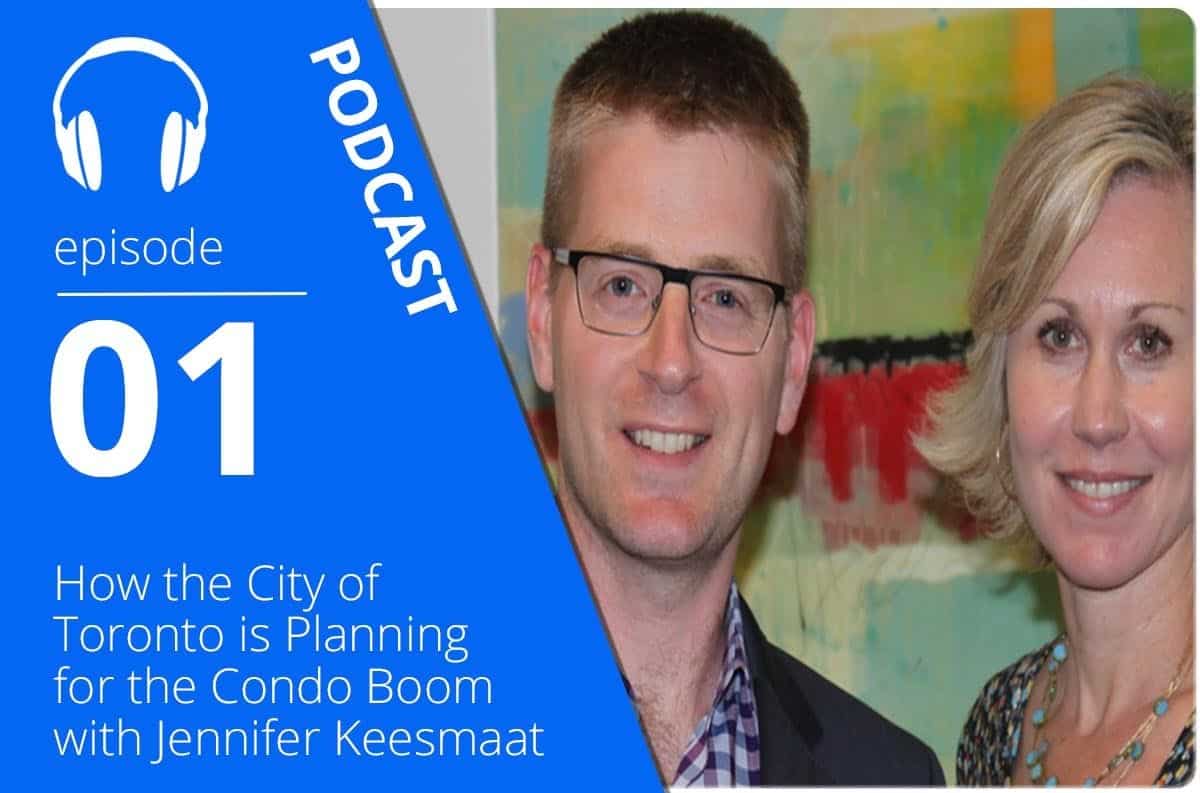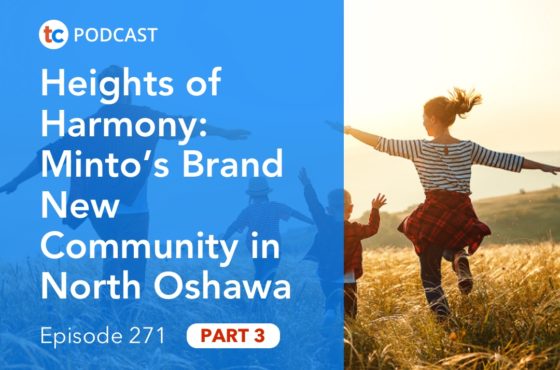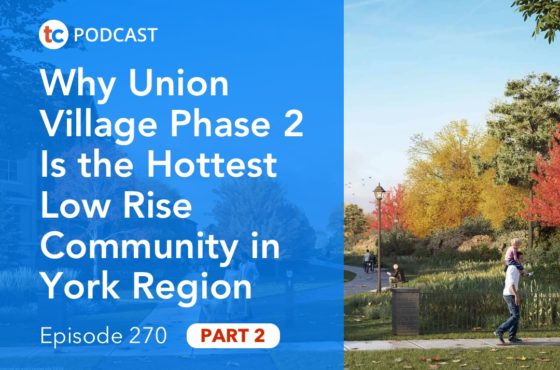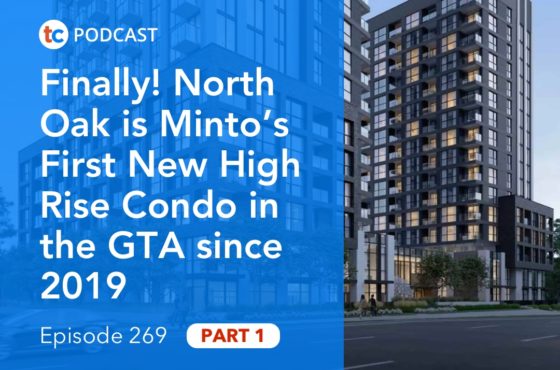How the City of Toronto is Planning for the Condo Boom with Jennifer Keesmaat

Andrew la Fleur from TrueCondos.com, interviews the Chief Planner of Toronto, Jennifer Keesmaat to discuss what direction she believes the Toronto condo market is heading in, what Toronto condo projects is she most excited about, and what concerns she has about the current and future state of the Toronto condo market.
Listen to the first episode of the True Condos Podcast to find out how the City of Toronto is planning for the Toronto condo boom.
Interview Highlights
0:00 Introduction
1:25 Who Is Jennifer Keesmaat?
2:08 How Jennifer Got Into Urban Planning
4:45 What is Jennifer Most Excited to be Working On Right Now?
6:00 What Does Jennifer Like About the Condo Market in Toronto?
7:30 What Is Jennifer’s Biggest Concern Regard the Toronto Condo Market?
10:23 Is There a Condo Bubble in Toronto?
12:11 What Is the World Saying About Toronto?
14:18 Is Toronto Going Through the “Manhattanization” Effect?
16:10 How is the City of Toronto Developing to Accommodate Families?
21:46 The Revitalization of Regent Park
23:38 How is Toronto Planning for the Transformation of Its East End?
25:46 How to Find Jennifer Keesmaat
Read the Interview with Jennifer Keesmaat Here!
Andrew: Hello, and welcome to the very first episode of the True Condos Podcast. I’m your host Andrew la Fleur. You may know me from truecondos.com, or maybe you’ve read some of my articles in New Condo Guide Magazine, or maybe you’ve never heard of me and that’s okay. The point is that if you’re interested in learning more about the Toronto condo market and investing in condos, you’ve come to the right place.
The True Condos Podcast is a chance to hear from experts, and industry insiders about what’s really going on in the condo market, and sometimes we even find out where these insiders are putting their own money when it comes to condo investing. We cut through all the fluff, and deliver the straight goods. If you’re a condo investor, this information will help you make better decisions and better decisions will help you make more money.
This podcast is 100% free, but I just have one favor to ask of you the listener. If you like what you hear, and if you want to support me to keep doing more episodes, please, please, please go to iTunes and leave a review. It really helps to get show out there, and more people will be able to find it, if you leave me a great review. Thank you and I really appreciate. Okay, let’s get down with it, shall we?
For the very first episode of the True Condos Podcast, I’m really excited, that I have on the Jennifer Keesmaat. Jennifer is the chief planner of the city of Toronto, in a very real way, Jennifer’s leadership and her vision affects every single condo building in the city, both existing or planned condos. If you’re condo investor in Toronto, it’s very important to start the top, to look at the big picture.
Listen to what Jennifer has to say about what direction city is going, what the city’s priorities are and start thinking about how you as a condo investor can take advantage of the city’s growth plans. All right, here it is, my interview with Jennifer Keesmaat. Enjoy.
Okay, thanks very much for being on the interview today, really appreciate your time Jennifer.
Jennifer: My pleasure.
Andrew: It’s great to have you on. Why don’t we start by, you could tell us a little bit about your story, how did you get into planning. Why are you so passionate about planning, and maybe just give us a bit of insight into who you are and what you do.
Jennifer: Well it’s kind of funny, I really fell into planning by accident. Simply because I love cities, and I graduated with a degree in English and Philosophy. Once I graduated, I was like, “Now what do I do?” I thought I want to go into law, but I spent summer working in my uncle’s law office, and very quickly realized I had no interest in law, I did a lot of filing to be fair, but still I just didn’t like the competitive process the competitive nature of law didn’t interest me.
It was during that time, I was trying to figure out what came next in my life. I was at a party, and I met someone, and we’re talking about a whole variety of different issues. He looked at me and he said, “Are you a city planner?” I look back at him, and said, “What’s a city planner?” I have no idea, I have no idea at all, what a city planner is. At that point he suggested I go away and read, Jane Jacobs seminal book, the Death and Life of Great American Cities.
I did, I went away, and read the book. I decided to take some courses at the school of community and regional planning at UBC. Because I was living out in Vancouver at the time, and when I walk in that school, I felt like I was home. I thought, “This is it, this is … I’ve long here.” These are my people, these planners, my husbands like to call this nerdy planners. That’s totally me, 100% very, very nerdy planners.
That was how I ended up stumbling upon planning as a profession, and from that point forward really getting engaged in planning as a professional, I went and undertook my masters degree in planning. Following that, I started up my own firm, I’m an entrepreneur, started out my own company with two other young team idealistic planners. We grew our practice, and eventually became a national practice with four offices, across Canada.
We merged with a couple of other disciplines engineering and architecture, in order to create a new company, called dialog. That’s where I was, when I was recruited into this position. That’s a very short snapshot of my journey into planning.
Andrew: That’s great, what are you, I know you’re … As a chief planner, you’ve drawn your focuses on a lot of different things, but what are you, in terms of right now what are your most passion about, what do you most excited about in terms of what you’re working on right now?
Jennifer: There so much going on, that question came on a million different directions and quite frankly we changed from day to day. I am very excited about the work that we’re doing around transit planning, and reorganizing how we undertake transit planning to ensure that we’re meeting our city building objectives. That’s been a really key piece of work for me, and it is very exciting.
I’m very excited about what we’re calling reset TO, which is the development permit system, and it’s all about shifting from site by site planning, to neighborhood base planning. Focusing on how we ensure that as we’re changing in growing, that we’re also planning for all of the critical infrastructure needs. Parks, play spaces, spaces for dogs, community amenities, employment lends, how we’re ensuring that we have the right critical mix to be creating places across this vast geographical area known as Toronto.
Where people can live in, and work within their neighborhoods.
Andrew: That’s great, now within that, I know that you deal a lot with condo developers, and obviously this podcast is about, condo market, and investing in condos. What do you … in terms … What do you like, about what you see in the condo industry or in the condo market right now. What’s good about it and on the flip side what do you wish would change or where do you see areas of concern in the condo industry, or the condo market.
Jennifer: Well one of the areas I’m very excited about, is I think we’re beginning to see some real innovation, and I might be seeing it, and you might not yet be seeing it, because I’m seeing it at the application stage. We’re beginning to see some real innovation with respect to our new buildings that are coming forward. We have a new developer in town, who’s here from Vancouver, who has a project that he wants to make greener than green.
He’s interested in really looking at incredible innovations around green technologies, geothermal, district energy, he’s really trying to push the envelope. I see that’s as being extremely exciting because it’s of course critical to our future. We have innovation on the green side, the green technology side. We also have innovation on the architecture side. Do some very interesting mid rise buildings for example.
I think that’s very exciting and is going to lead to a housing typology that really improves quality of life, and enhances quality of life I the city.
Andrew: That’s great, again on the flip side, is there anything that … Any big concerns that you have about the condo market, or are there any red flags or any areas of challenge that you’re seeing with the condo market?
Jennifer: I think the biggest challenge for my perspective which is an ongoing challenge in any environment that’s going very, very quickly is ensuring that we’re building for longevity, that the buildings we’re building are going to be a … Here a 100 years from now?
Andrew: What does a hundred year building look like? What criteria do you look for?
Jennifer: Well, I’ll just say, this is something I’m concerned about, I don’t think it’s something that we evaluate very well, and impart there’s the planning work that we do in city planning around identifying where the buildings go, what the massing should be what the open space should be, how they integrate into the larger infrastructure in the city. Then there’s actually the building itself, and that’s regulated by the Ontario building code.
We make recommendations, or suggestions to the province all the time, in terms of how would like to see the building to go change, but it’s not something that we have jurisdiction to change ourselves. Because it is provincial regulations, I just want to qualify what I’m going to say, because a lot of where I do in fact have concern is around … it’s around that quality. For example, a hundred year old buildings.
Inevitably you’re going to need just like on a house, when you’re building a condo, there’s going to be a moment when you need to replace the windows. I live in a hundred year old house in the city, I had to replace my windows last year. That’s not an unusual thing, if we take a tower, a condo tower, then you think about the investments that are going to be needed over the lifespan of that building.
The extent to which the building has good bones, is going to determine how much longevity it has. It’s really fascinating the city, because some of our buildings that have the best longevity, or the best bones or actually concrete structures that were built, they were really built in the ’60s, and the ’70s.
Andrew: Give an example of the building that you sort of see as built in the ’60s, and the ’70s that’s really stood the test of time.
Jennifer: Well, really interesting building is the old four seasons on Bay street, just North of [Blor street 00:09:50] which is currently being transitioned from a hotel, into residential condominiums. To me that’s an example of a good adapter over used, it’s a fascinating example of using that embedded energy even when the lifespan of that existing building for it’s existing use has transitioned.
Raises the questions around our buildings, and I believed we needed to be understanding in the infrastructure, and their longevity as an important part of creating a sustainable city.
Andrew: You probably have this question a lot, but I’ll ask you again. Is there a condo bubble in Toronto, what’s your take on that question?
Jennifer: Well, I only get asked that question, 50 times a day. I get ask that question all the time. I always, I don’t believe we have a condo bubble. It’s kind of funny because if you look back in reporting about Toronto’s condo market. People have been saying we have a bubble for I don’t know, 15 years now which I think is quite fascinating at least. At what point does the bubble burst, or maybe it’s not really a bubble after all.
I’m non concern that we have a condo bubble only because we have very high occupancy rates, and because we have a tremendous amount of growth in our region. If we were building, that our region wasn’t growing I would be very concerned. We add approximately 40,000 people to the city every year, 100,000 people to the region every year. There’s a tremendous amount of demand for the house and stock that we are in fact the building.
You get a bubble when there’s a gap between that demand, and what you’re actually building and we don’t have that gap. Does that means prices will fluctuate … Won’t fluctuate, well no. I think fluctuations and pricing is very different from a bubble. A bubble is something that pops, it goes poof, and it’s gone. It’s sort of disappear, the market disappear. Will there be corrections, and justifications in our market?
There will always continue to be. I think that’s a normal part of the phase between building and occupancy and growth, it tends to ebenflow. Is that a bubble, absolutely not. We don’t have a bubble, and I don’t think we’ve had one.
Andrew: When you travel with your work, and you speak to people in different countries and different cities around the world? What are people saying about Toronto, what are they sort of envious of Toronto and what are they, what misconceptions do people have about Toronto?
Jennifer: It’s a great question in part, because I spoken international conference last week, and there was a planner from the UK, who have never been to Toronto. He came to Toronto, prior to heading to the conference, and the city sort of blew his mind. He was just like, “I couldn’t believe what he saw going on here.” Most people from around the world, simply just don’t belief the growth that we have until they see it with their own eyes.
In some ways, we are so frustrated by our traffic congestion, and we’re so frustrated by all the construction going on in the city, that it’s difficult for us to pull back, and to see this is part of an incredible transformation that our city is undergoing right now, and it’s very, very exciting, yes it’s very annoying, but it’s very, very exciting …
Andrew: It’s a good problem to have.
Jennifer: It’s a great problem to have. I was in Buffalo recently and I have to tell you my heart was breaking in Buffalo, because I can tell you there is no traffic congestion, and there is no pedestrians, and there is not a lot of night life, and most of US cities, other than a few rarefied US cities that is in fact the case.
It made me profoundly grateful for the growth that we see, I think the biggest misconception is people don’t really appreciate the magnitude of the transformation we’re undergoing. We say, yes Toronto is the fastest growing city in North America, but people get here and they go, “Holy smokes.” It’s incredible how quickly this city is changing. From my perspective that’s an opportunity for us to kind of grab that bull by the horn, and say “Let’s wrestle this growth to the ground. And ensure that we’re the outcome of all this growth is going to be a fabulous inspiring livable inclusive green city.
Andrew: That’s great. Is Toronto … What direction are we heading? Are we becoming the next New York, is this Manhattanization effect that some people talk about a real thing?
Jennifer: Well, I’m not sure if the Manhattan effect when people talk about it, is there a good thing, or a bad thing. In general people in Toronto do love New York City. I think most people in this city admire New York City. There’s not that many people who live in Toronto who want to live in New York City, or can afford to. I think that, I’m never quite sure what those statements mean.
The reality is the vast majority of our land base in the city of Toronto is low density suburban, and is going to stay that way. I think the way we’re changing and transforming is actually quite different from Manhattan. Just because we have lots of tall buildings going up, currently doesn’t mean that … I don’t really see that as being, what our future looks like, impart as well we have a massive land area.
I think we’re five times a size of Manhattan, 613 square kilometers. Most of which is Suburban, and we have a profound opportunity to be transforming our avenues into mid-rise communities, into mid-rise neighborhoods. That’s a very different built form from what you see for example in Brooklyn, just outside of Manhattan. We’re building tall towers, there is lots of good things New York does our culture food, entertainment that I think we begin to do too, that adds real vibrancy in the city. Maybe I’m too close, I see the differences.
Andrew: All right, let me ping you a picture, you probably heard, you’re familiar with the story that 10 years ago in the city, we were building in terms of new housing around three low rise homes for everyone, high rise condo. Now today, 10 years later that relationship has pretty much flipped, we’re building about three condos for every one house. We’re seeing massive shortages of inventory of the low rise resell market and we’re seeing a growing amount of inventory you could say, in the high rise market.
The high rise market, the unit size is tend to be getting smaller and smaller. Families, at least what I’m seeing as a real estate agent, families are really being pinched out of the low-rise market but yet there’s not a great number of alternative in the high-rise market for families. I don’t know if you thought about that, or you talk about that in the city, in terms of what you’re planning.
How do you look at that problem, how do you see the city developing over the next 20 years to accommodate families?
Jennifer: It just happened in the past couple of years, where the downtown core, the condo market is going faster than the suburban market in the region. That’s a really significant transition. One of the reason that’s happened is because of the places to grow act, and the greenbelt surrounding the region. Which in fact limited the amount of suburban sprawl and has driven the growth into already existing built up urban areas.
Well when you’re building an areas that area already built, you’re not building single family homes. You’re really trying to squeeze a lot more of your land value and as a result you start to see, the first transition that you see is to semis then rose, towns, and then you start moving into mid-rise buildings, and then eventually towers, and you see that transition taking place across the region.
I believe this is a good thing, because I think that 20 years from now, when we will continue to live off the fresh food, grown in our greenbelt, we will … Our children will turn to us, and they’ll thank us, particularly as energy cost rise, and the cost of transporting strawberry’s from California starts to become an absurdity the fact that we can actually grow food in our own region, we’ll only become more, and more critical, and more and more important.
Access to clean water is a really critical part of that as well. I see it as a necessary transition, the next question becomes, as if we know it’s not desirable to sprawl on indefinitely. If we can agree to that as a general consensus then the question becomes how do we create livable community environments in a housing form that is different than what we may perceived to be as a traditional housing form.
It’s important to remember that sprawl itself was an outcome of really what was highly subsidize following World War II, highly subsidized and we’re deter … We’re learning that, it’s not a very sustainable land form. We didn’t quite have it mastered with that approach to family housing. We’re still exploring now, and trying to figure that out. One of the things we’re doing in city planning, and I held a round table about a month ago, on this topic is this question of raising families in the urban core.
Because in the context of a planning study we’re doing in the densest parts of the city. Part of what we’ve learned, is that we in fact have a mini baby boom. We do, we have a mini baby boom going on in the downtown core. As those families, as their children begin to grow, they’re asking a very important question. Where am I going to live, how am I going to afford housing in the core, because guess what I sort of like it down here. I don’t actually want to move out of the city, or move out to Vaughan and have a two hour commute every day, thanks very much.
Andrew: Or even out to Riverdale or down …
Jennifer: Exactly, or even out just a little bit. The good news is, we already understand this, and we have an excellent model in St. Lawrence neighborhood, we did this back in the ’70s in St. Lawrence neighborhood. We created a fabulous mixed used communities, with schools, with daycares, with public spaces and parks for children to play in, and that model of a neighborhood has proven to be a wonderful brilliant success, a brilliant success.
We can actually point to that, as an example of what we need to do more of, the challenge that we have. We need more family units in our condos, we are requiring … Last week I had two projects, that we moved through the approval process. Both of those projects we’ve secured 10% 3 bedroom units. The problem is just because we secure them at a planning level, doesn’t mean they’re going to be affordable for families.
This is a really important question, that we’re continuing to work through, one of the reason why it’s tricky, tricky for families in the downtown or in an urban places, is because the cost of housings gets so high. We’re continuing to do a lot more work in that area, we’re looking at incentives, we’re talking to the development industry. This month I’m participating on a round table on affordable family housing.
It’s being hosted by CHMC, and we’re collaborating them precisely because we see this as an critical, critical question that we need to unlock.
Andrew: There’s a huge transformation that’s taken place all over the east side of the downtown. Could you talk to us about that, and in particular the revitalization of Regent Park.
Jennifer: Sure Regent Park is a really interesting story, in this city. In part because Regent Park when it was first built out as a neighborhood was in fact Victorian Row Houses. Then came revitalization in the ’50s and ’60s which resulted in closing off the grid, wiping out all of those homes, and building the built form, the tower and the park model that was meant to really be an ideal community living model. It turned out to be a terrible model. The buildings were situated on the property in such a way, that they created a lot of dead spaces that were unsafe.
Disconnecting the streets from the rest of the street grid, rather than making it quite Utopia, made it a dangerous environment. Now we’re at the next iterations of Regent Park which is reconnecting the street grid, creating a mixed used community where there’s a diversity of incomes and a diversity of different housing types and really increasing the choice.
Great amenities like Daniel Spectrum, the New Community Center, the park which is being built right now with the community gardens are all adding the community based amenity to really create a strong connected community. Regent Park are really interesting example of a master planned community that’s gone through several iterations, and I think that it’s very clear that this last iteration is going to hit the mark.
Andrew: Really it’s … Wouldn’t you agree it is a big … I mean it’s … We’re only a few years into it now, what’s been done so far is a big success. I mean it’s working great so far, and it’s only about halfway done. How do you see, so much going on the East side, you can touch on briefly Regent Park, West [Armland 00:23:45] there’s a lot happening in [inaudible 00:23:46] all of these neighborhoods in the east side, they’re really starting to blend together and the east side is really changing a lot, isn’t it?
How is the city planning for all of that development that’s happening there.
Jennifer: Well you know, it’s important to know that what’s happening on the East end of the city is an outcome of over 20 years, worth of planning work. There’s been a tremendous amount of analysis due diligence, plants generated, community consultation process that really were living at a very exciting moment because we’re seeing that all rise out at the ground and come to fruition.
The West Armland is a fascinating model in part, because there’s a very generous public realm, Cork Town common is a very important storm water management feature, and also a brilliant beautiful, beautiful park. We’ve also been able to extradite the building of the West Armlands by tying it in with the athletes village for the Pan-Am games. It’s a really beautiful example of many, many years of work.
There are many hands that have touched that project, you can talk to [inaudible 00:24:51] any planning consultants in the city, and they will tell you the time, they work on it, they work on it at one point or another. I just had someone say to me the other day, I was presenting, and someone said, “20 years ago, I created the block structure for West Armland.” I was like, “Good God you were involved too?”
In many ways it’s kind of a … It’s a beautiful story about our story, and a beautiful story about the expertise in the city, and it’s now coming into fruition and I think that’s … What’s been built already, go to Underpass Park, Underpass Park is fabulous, it’s world class. I had someone approached me at a conference last week, after I gave a keynote, and say “Why didn’t you talk about Underpass Park.”
I said, “Well you know it’s a whole city, I can’t get everything in.” He said, “Underpass Park is just this incredible model of how you can build under existing structures.” I said, “Hey I don’t disagree with you.” The world is sort of taking note, I think for some of the great work that we’re doing in the East end.
Andrew: That’s great, thank you very much for your time today Jennifer. Really appreciate. If people want to get a hold of you, what’s the best way to find you online, or otherwise? How can people reach you?
Jennifer: There’s a few great ways to find me, one is on Twitter. My Twitter handle is @Jen Keesmaat. That’s a good way to find me, another great way to find me, is … You can find the things that I’m saying on my blog, which is ownyourcity. Then for more traditional matters. It’s very easy to call me, by calling 311, and just asking for the chief planner and they’ll put you straight through to my office.
Andrew: That’s great, well very generous offer, I’m sure some people will take you up on that. Thank you again for your time today Jennifer. Hopefully we can have you again on the podcast soon.
Jennifer: My pleasure.
Andrew: Okay, I hope you enjoy that interview with Jennifer Keesmaat the chief planner of the city of Toronto. For all the show notes on this episode, head on over through truecondos.com/jennifer. If you like the show, please leave me a review they are greatly appreciated. There will be plenty more great interviews being added to this podcast each and every week, I look forward to bringing you more episodes like this one. Until next time, thanks for listening. Bye-bye.
Thanks for listening to the True Condos Podcast. Remember your positive reviews make a big difference to the show. To learn more about condo investing, become a True Condos subscriber, by vising truecondos.com

Why?
- Be the first to know of Toronto’s newest preconstruction condo developments.
- Gain access to VIP price lists and floor plans.
- Real and unbiased advice, suggestions, and an insider’s scoop on exclusive condo investment opportunities from True Condos!




